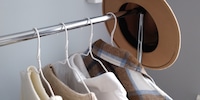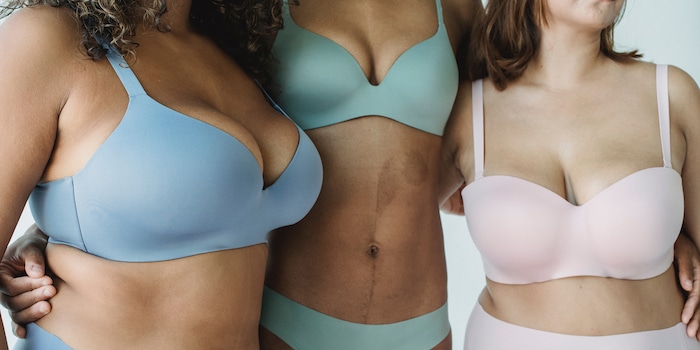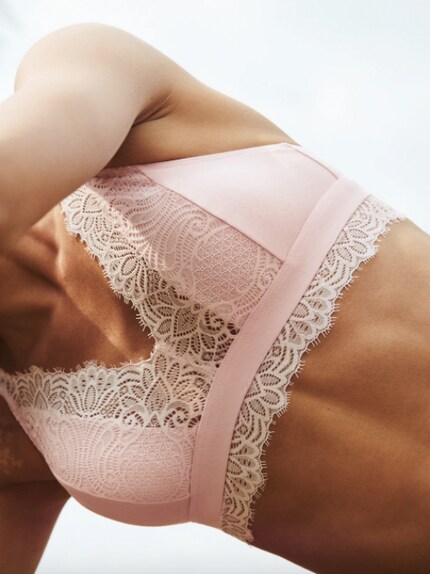
Guide
Oops! With these 7 habits you're unknowingly ruining your clothes
by Laura Scholz

How do you find your size? How do you wash them? What should you watch out for? I sat down with someone who knows their stuff – and got the answers to all my burning, bra-related questions.
The first patent for a bra was registered in 1899. And yet, 123 years later, the question of cups – and the right support – is still a mystery to me and many another women. Here’s where Janine Weiz-Bühler, Brand & Product Director at Swiss underwear giant Calida, comes in. She’s got the lowdown on how women can find their ideal fit, how to make bras last, and why the underwire bra has such a bad image these days. Side note: no one in my circle except me seems to be pro-underwire. In any case, Janine has shared her knowledge with me – and I, of course, will be passing it directly on to you.
So Janine, for starters, I’m wondering why bra sizes are still such a mystery to me and many other women.
Janine Weiz-Bühler: There are actually plenty of reasons for that – one being that both breasts might not be exactly the same. Because they feel they don’t fit the apparent norm, many women resort to wearing the bra size that they’ve always defined as standard. Secondly, your breasts change over the course of your life. Age, weight gain or loss, as well as your menstrual cycle and other hormonal changes can have an effect on your breasts. That’s why the measurements should be rechecked every once in a while.
What are the risks or downsides of wearing the wrong size bra on a long-term basis?
If your bra is too small, the material digs into your skin and creates unsightly rolls under your armpits. Constant tightness can lead to tension, chest pain and skin irritation. Bras which are too big or too loose, on the other hand, don’t support your breasts properly. This means your back muscles have to work harder to take the strain created by your breasts – particularly if your bust is on the bigger side – which can lead to back pain.
**Let’s nip this problem in the bud then. How do you find your ideal size? What factors do you need to consider? Would you recommend going to a specialist?
For the ideal bra fit, two measurements really count: the bust, which is generally taken at nipple level, and the under bust. Your bust measurement determines your cup size, which you can figure out by checking a bra size chart. Measuring under your bust gives you your band size. The result has to be rounded up to the next number divisible by five – 70, 75 or 80, for example. You don’t necessarily need to take off your bra to get an accurate measurement. However, if it’s padded, it’ll obscure the results. It’s also important to wrap the measuring tape tightly around your body. If you’ve got one at home, you can take your measurements yourself. Alternatively, our trained store staff are happy to help out with professional measurements and advice.
So, what kind of underwear would I be better off banishing from my wardrobe immediately?
Any bra that causes discomfort of any kind. The most important thing is that you feel comfortable in the product. After all, a well-fitting bra encourages upright posture, comfort and, with that, confidence.
Over the last few years, the underwired bra has kind of fallen into disrepute. Is its tightness, pinching or digging in merely down to incorrect sizing?
Like fashion in general, bra styles change and develop, too. Today, there’s increasing focus on natural looks and a soft feel. So, a sculpted underwire bra might seem at odds with that picture at first. But thanks to innovations in material and production, underwire bras have evolved, too. For several years, we’ve observed a general trend towards bras without underwiring. Because of the new way they’re made, they support smaller busts perfectly and guarantee flawless comfort. Very feminine Modal Lace bustiers and triangle-cup, wire-free bras, which feel soft and comfortable, are our undisputed bestsellers.

Summer is just around the corner, trailing spaghetti-strap dresses and strapless tops in its wake. How do you find a perfect-fitting strapless bra?
Same story as before. Nailing the size sets the right tone. After that, you can’t really go wrong. We also recommend any shade that resembles your own skin colour or delicate shades of pink. Definitely not white, as that can be seen through light clothing. That said, it’s trendy at the moment to intentionally show off a nice, lace bra or bustier in order to add another accent to your outfit.
Care is key: how – and how often – are bras supposed to be washed to get the best of them for as long as possible?
As long as you follow the care instructions on the label, you can generally keep your bra looking pretty for a long time. The gentlest way of washing bras is by hand, especially when it comes to delicate materials like silk or lace. If you prefer putting them in the washing machine, you should definitely use a laundry net and choose a gentle cycle at a maximum temperature of 30 degrees. High-quality delicate detergents protect the fabric and colours, while increasing the lifespan of the bra. Fabric softener and tumble driers, on the other hand, are not a good idea! The former gums up the spandex, causing the garments to wear out. And in the drier, you run the risk of the fibres fusing, which leads to the same loss of elasticity and colour. In order to maintain the perfect fit, a bra should be dried on a towel with the cups facing upwards – it shouldn’t be hung up. We recommend washing your bra after three to four wears – more often if it’s hot out, or if you’re sweating more.
Last but not least, is there a question about bras that nobody asks, but everyone should know the answer to?
Which is better – a bra or a bustier? A bra needs to fit perfectly, provide support, look great and be comfortable at the same time. Both bustiers and bras can easily meet those needs. Ultimately, it all comes down to the size. You should go for a bra if you have a bigger bust (C+) which needs support. For smaller cup sizes (A-C), however, a bustier does the trick.
Header image: Antonius Ferret via Pexels
Always in the mood for good hits, great trips and clinking drinks.
Practical solutions for everyday problems with technology, household hacks and much more.
Show all